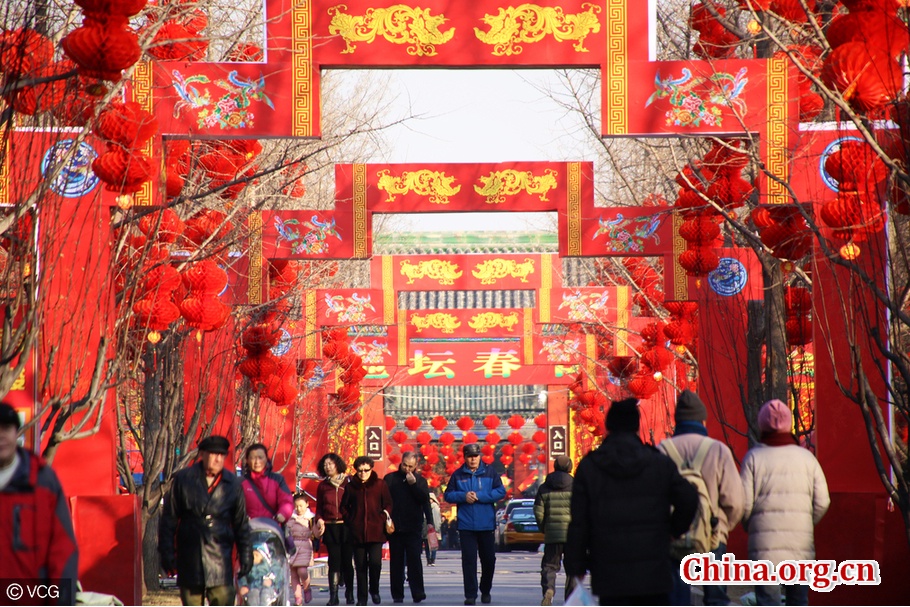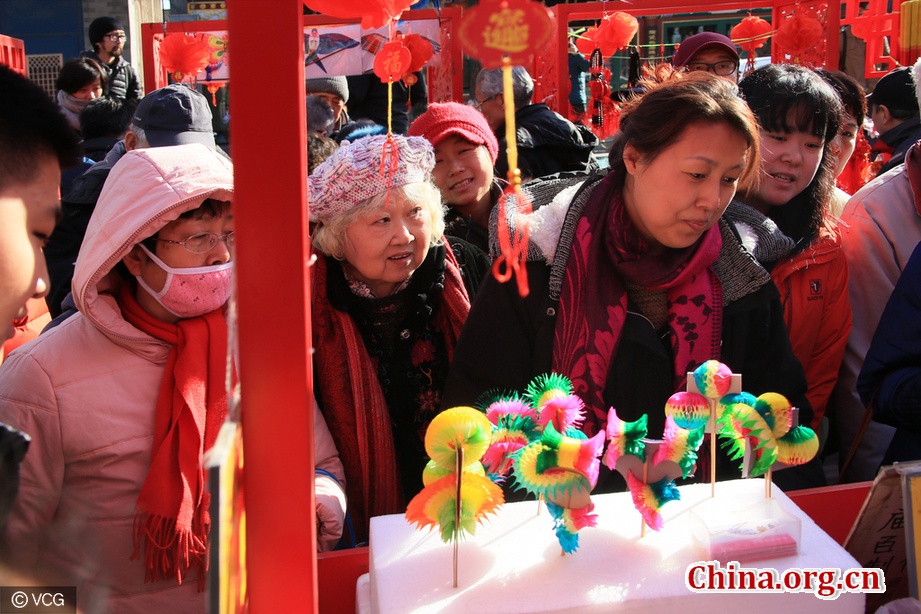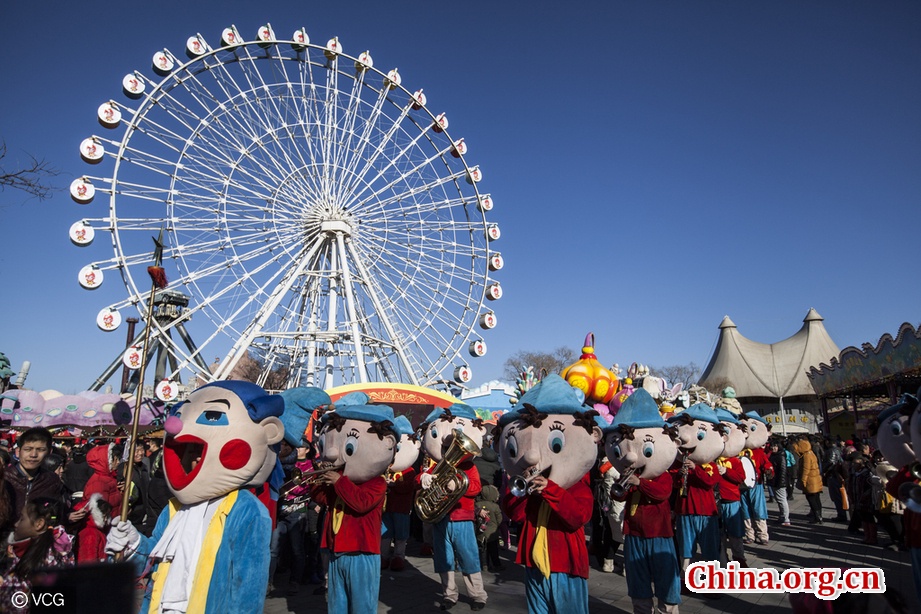
The tradition of a "temple fair" (Miao Hui) began as groups of vendors who did business near Buddhist and Taoist temples when many pilgrims came to pay tribute to the gods during traditional festivals. The practice grew, gradually turning into a regular event. Now temple fairs are an important and joyful destination for Chinese people during festivals, most especially the Spring Festival, or Chinese New Year.
Temple fairs in Beijing have a very long history, dating back to around 1000 AD, when they were called "Spring Outings," and saw a boom especially during the Ming and Qing dynasties (1368-1911) as well as the Republic of China (1912-1949). Major temples all have their own festivals, some of which are held regularly. During the Spring Festival, the temple fair is one of the most important activities, and a traditional cultural event that features all kinds of Chinese folk art. So far, there have been more than 10 major temple fairs held each year in Beijing.
In traditional temple fairs around Beijing, there are performances and booths demonstrating and selling traditional arts and crafts. The fairs have lots of games to play, food to eat, and performances to see, which attract lots of people. In the temple fairs you can taste numerous kinds of local snacks, court foods, and other dishes.
Most temple fairs feature dragon and lion dances, waist drum dancing, lotus blossom fairy dances, ground and clam dancing, as well as other folk performances, and some even stage traditional wedding ceremonies.
For foreigners, a temple fair is definitely a cultural experience, because it airs Chinese cultures from a very detailed perspective. While enjoying the samplings of Chinese delicacies, you can appreciate craftsmanship and artworks displayed by local artisans.
Nowadays, going to temple fairs has become a Spring Festival routine for residents in Beijing.

Ditan Temple Fair
Dates: Jan.28-Feb.1
Venue: Ditan Park, Dongcheng District
Admission: 10 yuan
One of the city's busiest temple fairs since 1985, Ditan (Temple of Earth) Park is the site of the altar where sacrifices were formerly offered to the earth god. This year's fair will climax with a performance reenactment of a Qing Dynasty sacrificial ceremony.
The Ditan Temple Fair will feature reenactments of traditional Ming and Qing ceremonies to worship the God of Earth. The park is the site of the altar where sacrifices were once made to the God of Earth.
This fair is one of Beijing's most popular and long standing. There will also be a range of folk performances, children's puppet shows and fashion shows, art exhibitions, ice lanterns and snow sculptures, and traditional Beijing snacks.
There will be a folk culture garden featuring song and dance of western China, as well as Red Storm Ditan Rock Concert. On the south side of the Sacrificial Altar, visitors can sing karaoke.
Other activities include a folk flower fair, an acrobatic show, Quyi performances, a fashion show, and a tea serving.

Longtan Temple Fair
Dates: Jan.28-Feb.1
Venue: Longtan Lake Park, Zuoanmennei Dajie, Chongwen District
Admission: 10 yuan
Fair events here are very similar to those in Ditan. There will be various interactive competitions inviting visitors to join in arm-wrestling, rock climbing, and chess playing.
Activities including an opera show, an acrobatics show, a Quyi performance, Judo, wrestling, a table tennis competition for middle-aged and senior people, a folk diabolo-spinning competition (a game in which a two-headed top is balanced on a string held between two sticks), "World Carnival' entertainment programs for children, and delicious snacks from all over the country.

Changdian Temple Fair
Dates: Jan.28-Feb.1
Venue: Taoranting Park, Xicheng District
Admission: 10 yuan
The Changdian Temple Fair in Xuanwu District is a favorite outing for Beijing residents during the lunar New Year (Spring Festival). Changdian is a small street, but each year at the Spring Festival it, along with the adjacent areas, becomes a large market.
The Changdian Temple Fair formed in the Ming Dynasty (1368-1644) and became prevalent in the Qing Dynasty (1644-1911). After the founding of the Republic of China in 1912, trade in antiques at the fair increased markedly. With the downfall of the Qing dynasty, former residents of the imperial palace, as well as princes, nobles and descendants of deposed officials whose wealth and position were declining, came to sell off their treasures. After 1949, the fair continued to operate each year during the Spring Festival.
Nowadays, the Changdian Temple Fair draws people from all parts of the city to buy and sell paintings and calligraphic works, antiques, articles for daily use, children's toys, food products and seasonal fruit and vegetables. In addition, entertainment is provided at the fair in the form of acrobatics, conjuring and operas.
This is one of the temple fair sites particularly enjoyed by foreigners.

Daguanyuan Temple Fair
Dates: Jan.28-Feb.1
Venue: Daguanyuan Park, Xuanwu District
Admission: 40 yuan
This temple fair will be held at Grand View Park, a replica of the magnificent Daguanyuan garden of an imperial family described in the well-known Chinese novel A Dream of Red Mansions by Qing Dynasty writer Cao Xueqin (17l5-l763). Besides the traditional temple fair events, there will be shows of folk arts, extreme sports, Chinese kungfu, Kaifeng Pan Drums as well as the "Two-people show" (Er Ren Zhuan) from northeastern China.
The opera Concubine Yuan Paying a Visit Home, and Amusement in Red Mansion which was adapted from the novel A Dream of Red Mansions, will also be performed. The scenes of Baoyu Getting Married and Celebrating the Lady Dowager Jia's Birthday will also be reenacted at the temple fair.

Lianhuachi Temple Fair
Dates: Jan.29-Feb.2
Venue: Lianhuachi Park
Admission: 10 yuan
Located close to Beijing West Railway Station, the Lotus Pond (Lianhuachi) Park is regarded as the birthplace of the city of Beijing, bearing a history of over 3,000 years. The temple fair here is quite traditional, with more than 100 events going on to make the park an ideal place to enjoy Chinese folk arts and food.
Lianhuachi Temple Fair features a special landscape of Huaguo Mountain and Shuilian Cave, the residence of the Monkey King in Journey to the West.
Other song and dance performances, such as yangge and duets of northeast China will be performed, and Shifuxian, or poem-string, an over 200-year-old folk art on the verge of extinction will make its debut at the fair.

Shijingshan Temple Fair
Dates: Jan.28-Feb.3
Venue: Shijingshan Amusement Park, Shijingshan District
Admission: 50 yuan
To get there: Visitors can get to the park's south gate by taking the subway to Bajiao Youleyuan. The park is 100 meters west of the subway station.
Starting from 2000, Shijingshan Temple fair is a foreign-style temple fair. It is almost like a foreign carnival parade. A cinema of 4-dimensional movies will open alongside other events this year.
Exotic performances such as a Japanese fan dance, a Korean long-drum dance , Latin dance, a Russian song and dance performance and a cartoon show will be seen on the fair. There will also be other amusement programs, including those for children.
Also Ferris wheel in the Shijingshan Amusement Park will reopen during the temple fair from January 28 after a 600-day renovation. The ferris wheel is the only one of its kind in Beijing that allows a human to sit in, a new option for this year’s park visiting.

Chaoyang International Spring Carnival
Dates: Jan.28-Feb.2
Venue: Chaoyang Park, Chaoyang District
Admission: 10 yuan
According to Chaoyang District, the 2017 Beijing Chaoyang International Spring Carnival will be held in Chaoyang Park during the Spring Festival of 2017.
From January 28th to February 2nd, the 2017 Beijing Chaoyang International Spring Carnival will be held in Chaoyang Park. The Chaoyang International Spring Carnival began in 2002 and is becoming more and more popular among people. As one of the largest cultural programs of Beijing, it is a combination of entertainment, shopping and sport. Characterized by the distinctive activities, the Spring Carnival will provide domestic visitors and foreign tourists with unforgettable exotic experiences.




